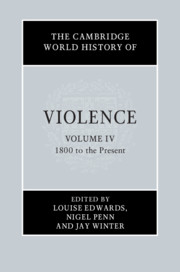Book contents
- The Cambridge World History of Violence
- The Cambridge History of Violence
- The Cambridge World History of Violence
- Copyright page
- Contents
- Figures and Maps
- Contributors to Volume IV
- Introduction to Volume IV
- Part I Race, Religion and Nationalism
- Part II Intimate and Gendered Violence
- Part III Warfare, Colonialism and Empire in the Modern World
- 11 Frontier Violence in the Nineteenth-Century British Empire
- 12 Genealogies of Modern Violence: Arendt and Imperialism in Africa, 1830–1914
- 13 Religious Dynamics and the Politics of Violence in the Late Ottoman and Post-Ottoman Levant
- 14 Violence and the First World War
- 15 Witnessing and Fighting Nazi Violence during World War II
- 16 Violence and the Japanese Empire
- Part IV The State, Revolution and Social Change
- Part V Representations and Constructions of Violence
- Index
- References
14 - Violence and the First World War
from Part III - Warfare, Colonialism and Empire in the Modern World
Published online by Cambridge University Press: 13 March 2020
- The Cambridge World History of Violence
- The Cambridge History of Violence
- The Cambridge World History of Violence
- Copyright page
- Contents
- Figures and Maps
- Contributors to Volume IV
- Introduction to Volume IV
- Part I Race, Religion and Nationalism
- Part II Intimate and Gendered Violence
- Part III Warfare, Colonialism and Empire in the Modern World
- 11 Frontier Violence in the Nineteenth-Century British Empire
- 12 Genealogies of Modern Violence: Arendt and Imperialism in Africa, 1830–1914
- 13 Religious Dynamics and the Politics of Violence in the Late Ottoman and Post-Ottoman Levant
- 14 Violence and the First World War
- 15 Witnessing and Fighting Nazi Violence during World War II
- 16 Violence and the Japanese Empire
- Part IV The State, Revolution and Social Change
- Part V Representations and Constructions of Violence
- Index
- References
Summary
The Great War, as it began to be called as early as 1915, was a traumatic event in the life of everyone who lived through it. Industrial warfare fundamentally changed the experience of combat. In the midst of battle, physical violence fused with moral suffering. Mass death reversed the normal succession of generations. War crimes and genocides were committed against enemy civilians. The First World War was also a war of words and images. The new “cultures of war” served both to stigmatize enemies (external and internal) and to mobilize the home fronts. Yet this cultural mobilization did not remain unchanged throughout the war: the initial mobilization in 1914-1915 was followed by a process of disengagement, and later by a form of remobilization at the end of the conflict. Finally, the First World War did not end without a feeling of profound anxiety over the future of millions of veterans, who had experienced mass death and extreme violence on the battlefields. The question of violence is at the core of a new historiography studying the boundaries between war and peace, the legacies of the Great War in a global context and the “brutalization” of post-war politics.
- Type
- Chapter
- Information
- The Cambridge World History of Violence , pp. 286 - 303Publisher: Cambridge University PressPrint publication year: 2020



